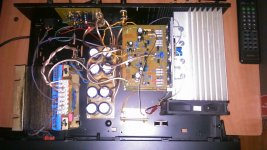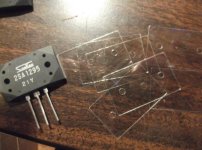The simplest way to test this proposition is to read the temp at the base of the heatsing with an IR thermometer, and at the top.
I will try it tonight on my sx-amp after its been on for an hour and report back later.
The only problem there is an IR thermometer won't give you a proper reading on a shiny surface. It'll be okay if your heatsink is dyed black.
black body radiation does not mean it has to be non shiny black
The errors in reading black body radiation as one moves away from non shiny black increase quite slowly at first and then become nonsensical as shiny aluminium is approached.
That why these emergency blankets use shiny aluminium as insulators.
If you are using a non ideal radiator and measure the temperature at the bottom and at the top, the error from non shiny black will be similar for the two locations on the same heatsink.
The errors in reading black body radiation as one moves away from non shiny black increase quite slowly at first and then become nonsensical as shiny aluminium is approached.
That why these emergency blankets use shiny aluminium as insulators.
If you are using a non ideal radiator and measure the temperature at the bottom and at the top, the error from non shiny black will be similar for the two locations on the same heatsink.
My stupid part is I can't understand what the english is telling me.
I think he's trying to say there is individual convection cycles at each hot spot. Whatever the case air is moving so heat is being dissipated so life is good. If it doesn't move as much at cool spots it helps to even the temperature anyway. All this really isn't that important for listening to music. It might come into play if you are playing sine waves all day but to me that's not the reason I'm building an amp.
It's a basic comparative measurement, so absolute numbers may be out, but if there is a differential we should be able to detect it.
Here are the resuls
sx-amplifier powered up for 1 hour
Ambient temperature 20 C
Temperature at bottom of heatsink between fins 45.6 C
Temperature at top of heatsink between fins 51.0 C
Here are the resuls
sx-amplifier powered up for 1 hour
Ambient temperature 20 C
Temperature at bottom of heatsink between fins 45.6 C
Temperature at top of heatsink between fins 51.0 C
Temperature directly on the transistors body?It's a basic comparative measurement, so absolute numbers may be out, but if there is a differential we should be able to detect it.
Here are the resuls
sx-amplifier powered up for 1 hour
Ambient temperature 20 C
Temperature at bottom of heatsink between fins 45.6 C
Temperature at top of heatsink between fins 51.0 C
It does matter.
The top row of devices will run much hotter than the bottom row devices.
10degrees will make a big difference to temperature de-rated SOAR, if you are running at Tc=70°C that becomes 80 for the upper row.
If it were Tc=50°C that became 55, then there is not much difference.
Agree with Andrew on that
Small details like that make huge difference in long run and provide the reference between good and perfect designs
Temperature directly on the transistors body?
no - this was taken on the actual heatsink on the outside between the fins.
It will be interesting if you can measure directly on transistors body.no - this was taken on the actual heatsink on the outside between the fins.
This way we can see the mica or rubber quality.
I reported this in the Roender amp Thread.It will be interesting if you can measure directly on transistors body.
This way we can see the mica or rubber quality.
Mica with two layers of Thermal goop was less Thermally resistant than the quite good soft insulator with no Thermal goop.
Hi OS,from which you have bought these?I would trust the actual manufacturer with insulator choice (below).
Sanken MT-200 .... with VERY thin mica (included with devices).
os
Hi OS,from which you have bought these?
Digikey in the US sells them. I just bought a batch of them last week, comes with the micas.
You can also get the micas here
MT 200 Transistor Mica Insulator Insulation Sheet X 50 | eBay
Ciao!
Do
I know, but here in Europe we can't order fro digikey (taxes charge)
I see that Profusion sell Sanken also.
Farnell sells Sanken.
- Home
- Amplifiers
- Solid State
- Post your Solid State pics here

